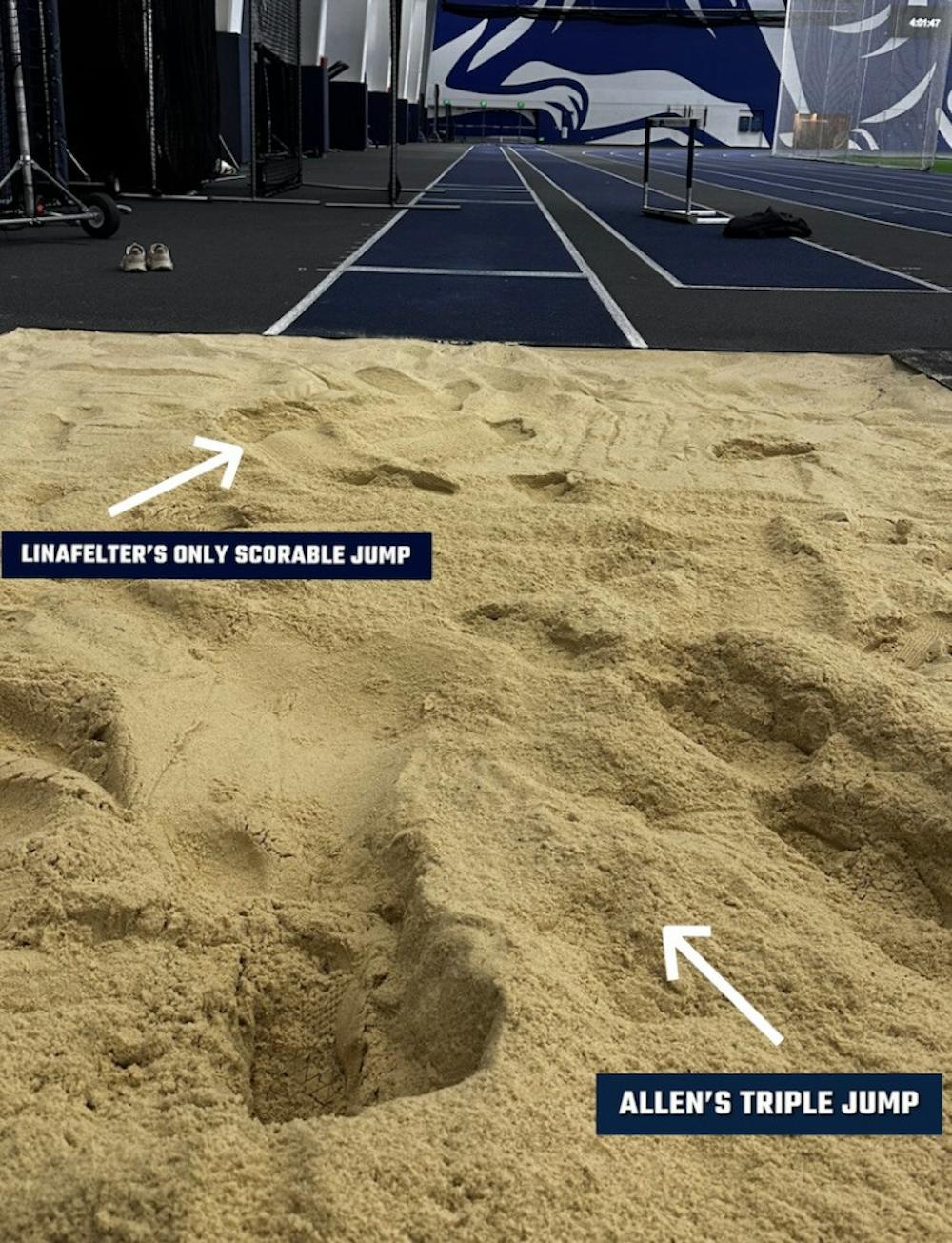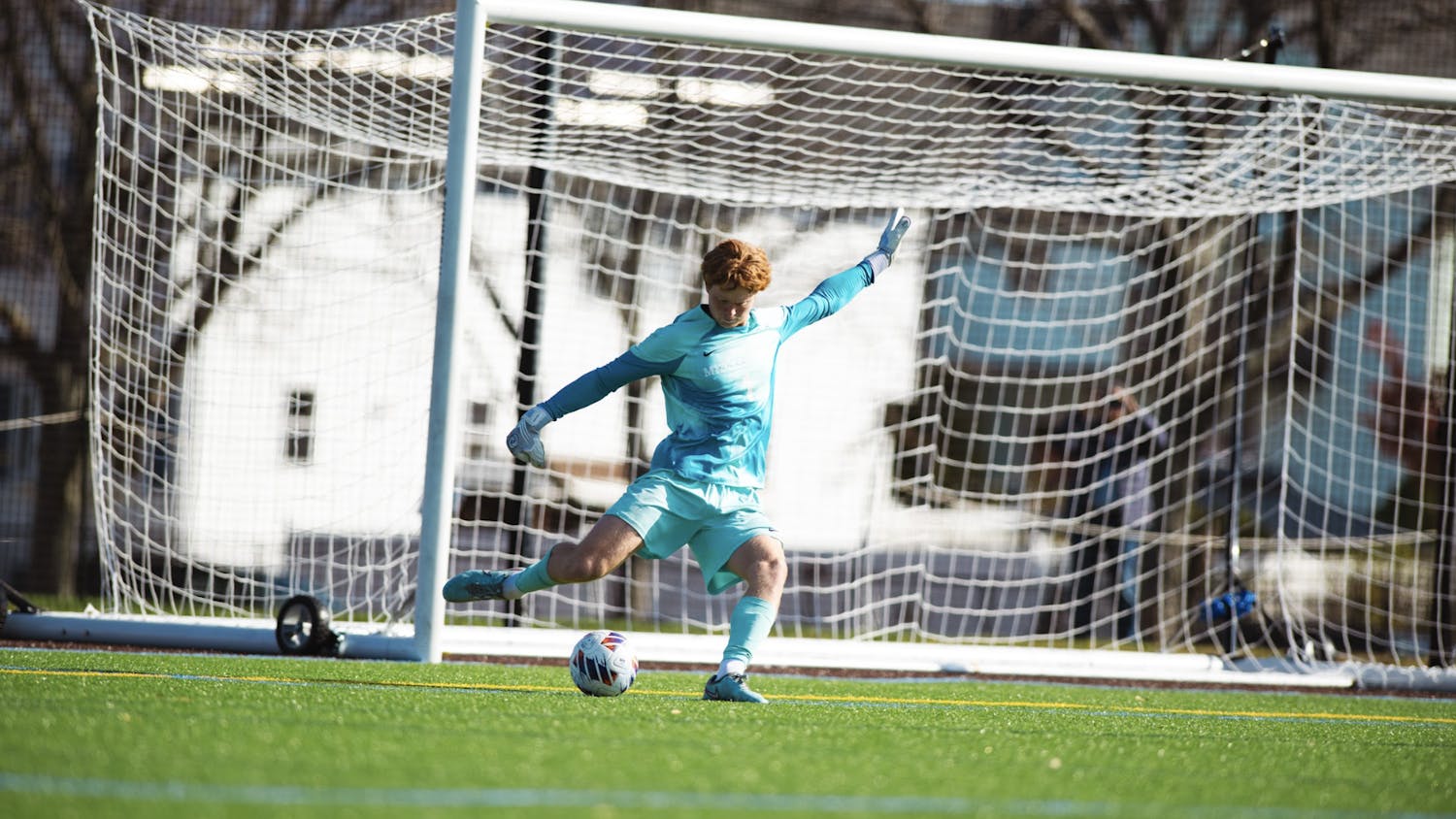Welcome to Amateur vs. Athlete: a column where we, lowly sports writers of The Campus and fans of our beloved Middlebury Panthers sports teams, delve into the mind of an in-season varsity athlete by challenging them to a one-on-one competition in their craft.
For the inaugural edition of A vs. A, I took on track and field athletes Maggie Allen ’24 and Ashley Raynor ’24.
The first event I tackled was the 800m on the indoor track. To preface, I consider myself an average runner. I can enjoy a pleasant jog when the Vermont sun comes out. I (usually) do not shy away from cardio, and I compete in a high-intensity varsity sport, though admittedly one that does not require running further than 30 feet. Despite rumors that the 800m is among the most grueling races, I cannot emphasize my lack of preparedness at the start of this race enough for the sensation that faced my quads by the end. In retrospect, I came out too hard and too fast trying to keep up.
Raynor dusted me head-to-head, faster than I would care to admit. I was able to finish this round of 1v1 without getting lapped, though while I flopped on the turf, Raynor was hardly sweating. After catching my breath and digesting my brutal defeat, I sought the scoop about what has kept her on the track:
Lexi Linafelter: How did you get into track?
Ashley Raynor: My mother is a marathon runner and has been running for pretty much her whole life, so it was something I always wanted to try but I started in middle school. I actually really wanted to play lacrosse, but there weren’t any spots on any middle school teams so I ran track and I ended up loving it.
LL: What do you like about the sport?
AR: It is so interesting because it’s such an individual sport, I mean, you’re obviously racing on your own but it still feels like you have a huge team aspect. There are 100 people on my team so it’s a great mix of individual and team aspects, especially for big championship meets.
LL: What is the hardest part about competing?
AR: It’s way too easy to get caught up in the little things. Your time can come down to .1 or .05 seconds and it’s so easy to get caught up in the tiniest details. That’s why it's so important, and I’m really lucky, to have a team environment where I’m able to lean on the support of my teammates through a really hard workout, or if I am just not feeling it that day.
LL: What is the most fun part of Middlebury Track and Field?
AR: When we’re all on the track together — Tuesdays are the best and worst because it’s our really hard workout day across all event groups and the best part is getting on the track with ~50 people and everyone is doing a different, really hard workout and cheering each other on.
LL: Can you explain this time of year to me?
AR: Indoor season was great, New England championships were pretty good a couple of weeks ago and the women’s 4x4 team just got back from NCAAs, so it was super cool to send a group of four women down to Virginia Beach and see them do so well. Right now is a really big training block for most of the team, so everybody minus those four is training pretty hard during these couple weeks. So higher mileage, sometimes several days a week where you’re running more than once a day, and still having Monday-Saturday training makes this a pretty heavy training period.
LL: It’s your senior spring — what are you thinking about entering your last season?
AR: Our women’s team is looking to win our third NESCAC title — it is so crazy we [hadn’t] won in 20 years and in the past two years we’ve won so we’re totally looking for a three-peat. Our San Diego [training trip] will be awesome and I’m really excited to spend time with the team there. Obviously, it is a big training opportunity and I am looking forward to running in the sun, but this is also where so much of our bonding happens as a team. Between the big team events, running, and some other fun traditions we have for the trip, it’s always a really fun time and I’m looking forward to spending a ton of time together.
Next, I challenged Maggie Allen to a triple jump and 60m hurdles. I was excited for this one because I do consider myself an above-average jumper. As a middle hitter on the varsity women’s volleyball team, I would conservatively guess that I have jumped to full extension 50 times a day, six days a week, six months of the year, for nine years. You do the math!
Naively, I hoped that this would give me an advantage in the jump events. I was wrong. Allen performed with ease and rhythm, and after one attempt, I was amazed by the coordination required to receive a scorable result in the event. It was quite fun and I happily returned to battle for a second attempt. I made the pit once, barely. Even varsity triple jumpers scratch, so I’ll leave the amount of fouled efforts I put forth to your imagination.
In hindsight, I should have anticipated that the 60m hurdles would be an extreme challenge. Even without meet-day intensity, Allen leaped over all five hurdles and watched from the end while I tripped, knocked each hurdle over, and paused several times to collect myself. It was obvious in both events that properly timing the sequence of maneuvers required to get off the ground is one challenge; it is quite another to do it thousands of times, under pressure, braving the elements of an outdoor track meet, against similarly-talented jumpers. Brushing off the sand, I caught up with Allen about how she does it:
LL: First, what events do you compete in?
Maggie Allen: Indoor, I do 60m hurdles, triple jump and the occasional long jump. Outdoor, I do 100m hurdles, triple jump and long jump, occasionally.
LL: What do you like about the sport of track and field?
MA: I just think the energy at a track meet is totally unmatched. From an outside perspective it might seem like track is a really individual event but in fact, it’s the closest I’ve ever felt to a team that I’ve been on. I think it’s because you’re so exposed, you’re out there on the track alone but you know your entire team is behind you supporting you.
LL: Has your favorite thing about track changed at the collegiate level?
MA: Competing at the collegiate level has allowed me to embrace what it’s like to be a part of a really powerful female environment. I think that is something really special that I had in high school but I know many aren’t so lucky, and coming into college and being able to be a part of a group of ~60 extremely strong women who have totally different perspectives and come from different backgrounds has been so cool.
LL: What is the hardest part about the sport?
MA: I think the hardest part is that the track is 90% mental. Your body is capable of doing so much and the hard part is getting past the mental barriers. Honestly, that is a big reason why our team is so close; we’ve bonded in such mental struggle together. But, obviously, that is so applicable to life outside of track and I’ve learned so many lessons that benefit me in so many ways.
LL: I’d love to come back to the mental element, but first, can you explain this time of year to me?
MA: I think people assume it’s a smooth transition between two of the same types of seasons, but really the transition from indoor to outdoor track is a huge mental shift. For example, the track gets bigger; the elements are now a part of your race; your event distance often changes, like for me; indoors I run 60m hurdles and outdoors I run 100m hurdles. That means the way that you approach racing and training changes.
LL: How are you preparing mentally for the start of a new season?
MA: Our team is so good at setting goals. We set team goals and individual goals and staying in the present moment will be critical to being successful and prepared. Annabel Cloney [’25] always says it best, that “iron sharpens iron” and our word of the season is grit–it’s gonna be tough but focusing on being affirming to our teammates and knowing the support that’s behind you is important in good and bad races.
LL: It’s your senior spring — what are your key goals?
MA: Of course, the goal for the team is a three-peat in the NESCAC. It’s going to be super challenging, the NESCAC has gotten a lot stronger over the years which pushes us but I think we can do it. On a personal level, I think it’s just going to be taking it all in. Being in season for most of the year means I have to remind myself that I don’t have much time left and I really just want to enjoy every second of these next eight weeks.
Maybe it was my lack of any technical training whatsoever, but my ability to combine the physical requirements of the events with the concentration they demand was thoroughly outclassed by my varsity opponents.. The respect I have for track athletes (while already exceedingly high) soared from this exercise, which I will certainly be reminded of as I nurse the bruises on my shins from my failures.
Editor’s Note: These interviews have been lightly edited for brevity and clarity.




